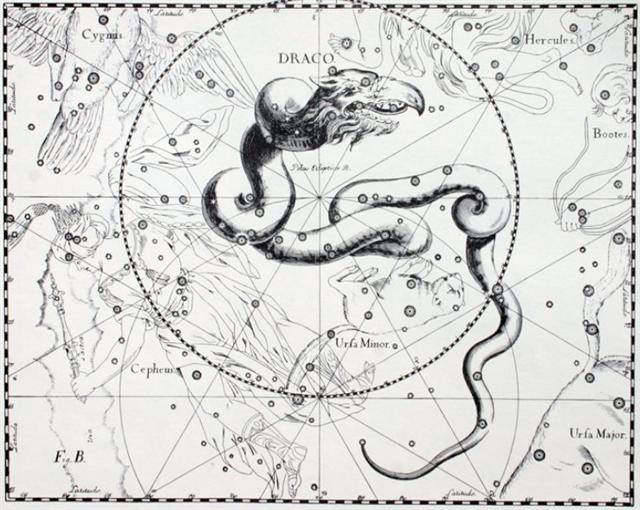| 1 |
Horn |
α Virginis (Spica) |
Crocodile |
(202.7) |
Oct 9 (282) |
282 = 265 + 17 |
| 2 |
Neck |
κ Virginis |
Dragon |
(214.8) |
Oct 21 (294) |
294 = 282 + 12 |
| 3 |
Root |
α Librae (Zuben Elgenubi) |
Badger |
(224.2) |
Oct 31 (304) |
304 = 295 + 9 |
| 4 |
Room |
π Scorpii (Vrischika) |
Hare |
(241.3) |
Nov 17 (321) |
321 = 304 + 17 |
| 5 |
Heart |
σ Scorpii |
Fox |
(247.0) |
Nov 23 (327) |
327 = 321 + 6 |
| 6 |
Tail |
μ Scorpii (Denebakrab) |
Tiger |
(254.7) |
Nov 30 (334) |
334 = 327 + 9 |
| 7 |
Winnowing Basket |
γ Sagittarii (Nash) |
Leopard |
(273.7) |
Dec 19 (353) |
353 = 334 + 19 |
| December solstice |
Metoro said rutu te maeva - the sky was moving - at the complex of glyphs early on side b of the tablet.
Initially I thought Polaris and the First Point of Aries (Sheratan) determined where the text on side a ended:
| April 11 |
12 |
13 |
14 (104) |
15 (471) |
16 |
 |
 |
 |
 |
 |
 |
| *Ca14-24 |
*Ca14-25 |
*Ca14-26 |
*Ca14-27 |
*Ca14-28 |
*Ca14-29 (392) |
| te henua |
te honu kau |
manu kake rua |
te henua |
te honu |
te rima |
| δ Phoenicis (21.5) |
no star listed (22) |
Achernar (23.3) |
no star listed (24) |
no star listed (25) |
ANA-NIA |
| POLARIS, Baten Kaitos (26.6), Metallah (26.9) |
| April 17 (107) |
18 |
19 |
| October 17 (290) |
18 |
19 |
 |
 |
 |
| Cb1-1 (393) |
Cb1-2 |
Cb1-3 |
| E tupu - ki roto |
o te hau tea |
| Al Sharatain-1 / Ashvini-1 / Bond-16 |
ι Arietis (28.0), λ Arietis (28.2) |
Alrisha, χ Phoenicis (29.2), Alamak (29.7) |
| Segin, Mesarthim, ψ Phoenicis (27.2), SHERATAN, φ Phoenicis (27.4) |
| Muphrid (210.1), ζ Centauri (210.3) |
φ Centauri (211.0), υ¹ Centauri (211.1), υ² Centauri (211.8), τ Virginis (211.9) |
Agena (212.1), θ Apodis (212.5), Thuban (212.8) |
I assumed there was a difference of 80 days between the dates and the right ascension days. I also assumed we should read the glyphs nakshatra wise on side b, and therefore I inverted my colours (blue respectively black).
Later, when I discovered there appeared to be a 3 days difference ('3 missing runes') - possibly due to the 'negligence' of Gregory XIII to correct for the 'unneccessary' leap years AD 100, AD 200, and AD 300 - I changed my mind:
... Vainamoinen set about building a boat, but when it came to the prow and the stern, he found he needed three words in his rune that he did not know, however he sought for them. In vain he looked on the heads of the swallows, on the necks of the swans, on the backs of the geese, under the tongues of the reindeer. He found a number of words, but not those he needed ...
... First 4 centuries / 13 later centuries * 10 days adjustment = 3 days difference. Regula de tri. The 3 leap days in 100 A.D., in 200 A.D., and in 300 A.D., were left intact in time-space. When the Sun reached 0h in March 21 it would have been to arrive at such heliacal stars which rose 3 days earlier than according to a correctly adjusted Julian calendar:
| Julian calendar |
Thursday, 4 October 1582 |
278 |
279 (October 6) - 84 (March 25) = *195 |
| 277 |
| Gregorian calendar |
287 |
Friday, 15 October 1582 |
289 (October 16) - 80 (March 21) = *209 |
| 288 = 278 + 10 |
| Julian correctly adjusted |
290 |
Friday, 18 October 1582 |
292 (October 19) - 84 (March 25) = *208 |
| 291 = 278 + 13 |
By shifting the dates ahead with only 10 days instead of with 13 days, the heliacal stars would not be properly placed in the calendar. Precession had pushed them a further 3 days into the year and measured from 0h their distances became to short. The adjustment from the Julian equinox date March 25 [325 as in the year for the Council of Nicea] to Gregorian March 21 in a way caused an opposite effect with 4 days, but this adjustment referred to the path of the Sun and not to the positions of the fixed stars ...
I therefore concluded that my first summary view (below) - could be wrong:
 |
 |
 |
| *Ca14-24 |
*Ca14-25 |
ACHERNAR |
 |
 |
 |
| *Ca14-27 |
*Ca14-28 |
POLARIS |
 |
 |
 |
| SHERATAN |
Cb1-2 |
ALRISHA THUBAN |












